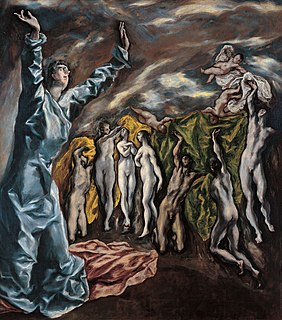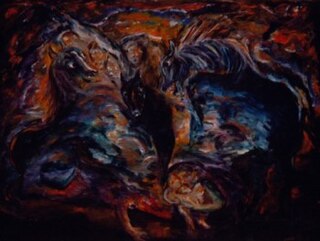
Apocalyptic and post-apocalyptic fiction is a subgenre of science fiction, science fantasy, dystopia or horror in which the Earth's civilization is collapsing or has collapsed. The apocalypse event may be climatic, such as runaway climate change; astronomical, such as an impact event; destructive, such as nuclear holocaust or resource depletion; medical, such as a pandemic, whether natural or human-caused; end time, such as the Last Judgment, Second Coming or Ragnarök; or more imaginative, such as a zombie apocalypse, cybernetic revolt, technological singularity, dysgenics or alien invasion.

Guernica is a large 1937 oil painting on canvas by Spanish artist Pablo Picasso. It is one of his best-known works, regarded by many art critics as the most moving and powerful anti-war painting in history. It is exhibited in the Museo Reina Sofía in Madrid.
The killer ape theory or killer ape hypothesis is the theory that war and interpersonal aggression was the driving force behind human evolution. It was originated by Raymond Dart in the 1950s; it was developed further in African Genesis by Robert Ardrey in 1961.

Ludwig Meidner was a German expressionist painter and printmaker born in Bernstadt, Silesia. Meidner is best known for his painted, drawn, and printed portraits and landscapes, but is especially noted for his "apocalyptic" series of work featuring his stylized visions of a pending transformation of Germany before World War I.

The Opening of the Fifth Seal was painted in the last years of El Greco's life for a side-altar of the church of Saint John the Baptist outside the walls of Toledo. Before 1908, El Greco's painting had been referred to as Profane Love. The scholar Manuel B. Cossio had doubts about the title and suggested the Opening of the Fifth Seal. The Metropolitan Museum, where the painting is kept, comments: "the picture is unfinished and much damaged and abraded."

The End of the World, commonly known as The Great Day of His Wrath, is an 1851–1853 oil painting on canvas by the English painter John Martin. Leopold Martin, John Martin's son, said that his father found the inspiration for this painting on a night journey through the Black Country. This has led some scholars to hold that the rapid industrialisation of England in the early nineteenth century influenced Martin.

Nabil Kanso is an American painter. Kanso began his career in New York. His works deal with contemporary, historical and literary themes, and are marked by figurative imagery executed with spontaneous and vigorous handling of the paint and often done on large-scale formats. They reflect movement and tension embodying intense colors and symbolic forms addressing social, political, and war issues. The Vietnam War and the Lebanese Civil War have profoundly affected the development and scope of his themes dealing with violence and war. His long-running Split of Life series encompasses an extensive range of enormous paintings depicting scenes of human brutality and suffering.

Lebanon is a mural size painting by Nabil Kanso depicting the Lebanese Civil War in a scene invoking the spirit and character of the people in the midst of horror and violence gripping the country. Amid the scene of chaos and devastation, two central figures reach across toward each other symbolically to represent the appeal for unity in defiance of the forces of division, destruction, and terror.

The Split of Life is a series of over 80 mural size oil paintings by Nabil Kanso. The paintings span a period from 1974 to 1994, and deal with contemporary and historical issues of war and violence.

Faust is a series of approximately 100 paintings created between 1976 and 1979 by Nabil Kanso. The paintings depict figural compositions in a sequence of scenes whose subjects are loosely based on Goethe’s 1808 play Faust Part One and Part Two.

Othello is a series of paintings executed in 1985 by Nabil Kanso. The subjects of the paintings are loosely based on Shakespeare’s tragedy Othello. The series comprises 60 paintings dealing with themes of love, race, jealousy, betrayal, and evil. They depict scenes embodying compositions of figural and metaphorical imagery that may be seen as visually reflecting the intimate and dramatic relationship between Othello and Desdemona, and the tense and uneasy relation that passes between and through Othello, Desdemona and Iago.

Place des Martyres is the title of a series of over 250 watercolors and drawings executed in New York and Beirut between 1971 and 1974 by Nabil Kanso. The subjects of the works in the series are based on the women headquartered in the red-light district of Beirut city center called el Bourj, and after World War I named Place des Martyrs French for Martyrs’ Place in memory of dozens of Arab nationalists who were hanged in 1915-16 during Ottoman rule.

America 500 Years is the title of a series of paintings created in 1988–91 by Nabil Kanso in commemoration of the 500th anniversary of the discovery of America. The works in the series base their subjects on historical events in the Americas over the course of five centuries.
Kuwait is a group of approximately 40 paintings made by Nabil Kanso in 1990–91 on the Gulf War and Iraq’s invasion of Kuwait. The works in the series were first exhibited in Kuwait in March – April 1992 at the Free Atelier Art Center and traveled in June to Caracas for a special exhibit at the Palacio de Gobierno in honor of the Emir of Kuwait’s visit to Venezuela. Then, the exhibition proceeded to Geneva and was held at the Red Cross Museum in July – August 1992.

The Vortices of Wrath is a triptych painted by Nabil Kanso in 1977. It is part of the Lebanon series began in 1975 in response to the Lebanese Civil War. The triptych is done in oil on canvas measuring 3×7.60 meters. The center is 3×3 meters and each side 2.75×2.30 meters.

The Floating Shadows is a triptych made by Nabil Kanso in 1986 on the brutality and suffering inflicted during the Lebanese Civil War. The painting is oil on canvas and measures 2.75 x 7.60 meters. It forms part of the Cluster Paintings series that Kanso began in 1986 and marks the transition to a new approach in his compositional framework. The pictorial layout divides the canvas space into various sections reflecting a cluster of interlinked planes depicting floating figures of predominantly dark-blue set against deep orange ground and demarcated by white grayish areas.

Apocalyptic Rider is a painting created by Nabil Kanso in 1980. It is oil on canvas measuring 7 X 9 feet, and is part of a series depicting horsemen in compositions dealing with apocalyptic themes.

Apocalyptic Riders is a diptych executed in 1984 and is part of a series begun in 1980 by Nabil Kanso.

Luis Cruz Azaceta is a Cuban American painter.

















